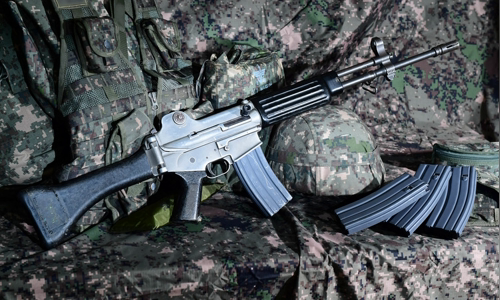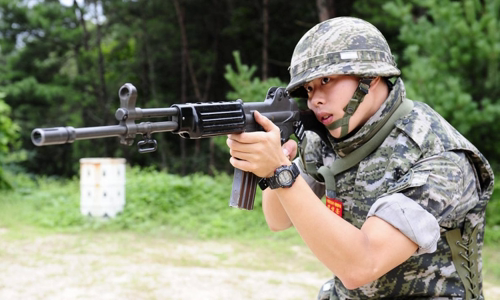Wishing to increase weapons autonomy, South Korea developed a hybrid K2 gun between the legendary American M16 and Russian AK.
By the end of the 20th century, one of the national standards of modern defense was the ability to design and build its own rifles. As an emerging military power, South Korea has been very focused on this field and as a result, the introduction of the K2, the "hybrid" assault rifle between two American M16 and AK Russian legends .

Korean K2 rifle Photo: Reddit
After the Korean War, the Korean army was mostly armed with surplus American personal weapons, mainly M1 Garands and M2 Carbine dating back to World War II. By the late 1960s, with a desire to become more independent in the field of gun production, the Korean group Daewoo signed an agreement with US Colt to obtain a license to manufacture the M16A1 gun.
However, when the license with Colt expired, the South Korean army was unable to continue producing rifles. Therefore, the Seoul government decided to design and manufacture its own rifles, carrying its own specifications and features.
The K2 design was introduced in 1984 and the first K2 guns were put into service in the South Korean army that same year. Basically, Korea copied and combined the best features on the "legendary" gun models then to create K2.
On the surface, the gun has many similarities to the M16, when Korean weapons engineers imitate the operating system of the AR-18 assault rifle of famous American weapons designer Eugene Stoner, the father of M16 gun. The trigger cluster of the gun is also very similar to the design of the AR model.
However, K2 is not quite the same as AR-18. Instead of applying the principle to the ammunition with short air extraction and the rotating barrel of the American gun, the Korean rifle model has a pneumatic loading mechanism with a long air extraction system and a spring repulsion similar to the legendary AK gun. Russian phone, and air tapping steps similar to Belgium's FN FAL rifle.
Weighing nearly 3.3 kg, the K2 weighs the equivalent of NATO's 5.56 mm caliber rifles. Military experts claim that the K2 has the exact mechanical characteristics of AR-15 but possesses the same power and reliability as the AK.
Since then, the K2 has served in the South Korean armed forces for the past 35 years and promises to continue to be upgraded for service in the coming years.
The gun is made entirely of metal stamping, adding some plastic parts that are durable and famous for their durability. Hundreds of thousands of guns have been produced and equipped for the majority of the forces in the Korean military, except for the reserve forces that continue to use the surplus US weapons and old M16A1 guns for a long time. .

A Korean soldier training with K2 rifles Photo: National Interest
K2 has a maximum rate of fire of 750 rounds / minute with three firing modes including single shot, three-shot series or fully automatic, can use the standard STANAG magazine of 30 rounds of NATO. Maximum effective range is 400 meters, the same as that of 5.56 mm caliber rifles.
In the early 2000s, S&T Motiv (formerly Daewoo) began to improve the K2 to integrate many new components that appeared on US and NATO rifles. The old-style lining was replaced with the Picatinny slotted liner on the new K2A guns.
These upgraded rifles are fitted with a red-point viewfinder and can incorporate laser target indicator lights and front handles, making them easy to improve, just like the modern rifles of the country. West.
During this period, the US Army developed a new type of infantry weapon called the Advanced Personal Battle Weapon (OICW), which is a hybrid of a traditional 5.56 mm assault rifle and a 20 mm grenade launcher. This prompted South Korea to develop a separate weapon and the K-11 was born.
Basically, the K-11 is a combination of K-2 and a 25 mm caliber grenade launcher. The K-11 is equipped with a ballistic computer, laser viewfinder, and electronic programmer for the grenade, which enables the gunner to adjust the grenade's crew, allowing the grenade to explode behind the enemy's fortifications.
While the US Army suspended the OICW project, the K-11 was still used by South Korea, greatly increasing the infantry's firepower.
Nowadays, the production of hand-held weapons is no longer the standard of a military power. For example, France is importing new model rifles from Germany to equip its army, while the UK may buy offensive rifles from abroad after 2030.
For South Korea, the K2 remains a key lightweight weapon in the country's army. Despite its "old" age, this weapon is still effectively and easily improved into newer, more modern and appropriate versions. With strong defense industry capabilities and its export-focused policy, the South Korean military is unlikely to use a foreign weapon to replace K2 in the near future.



 ArohaSamuels
ArohaSamuels







